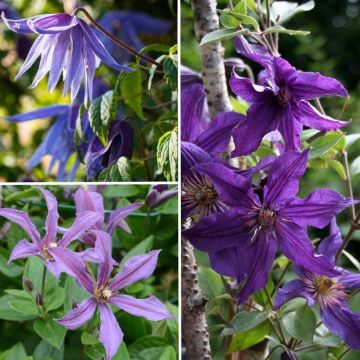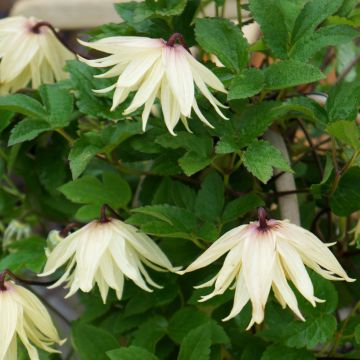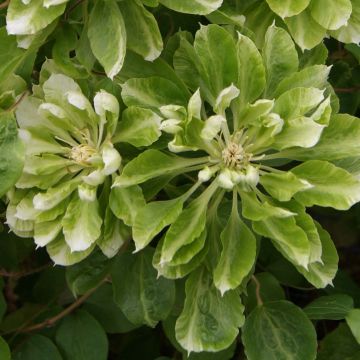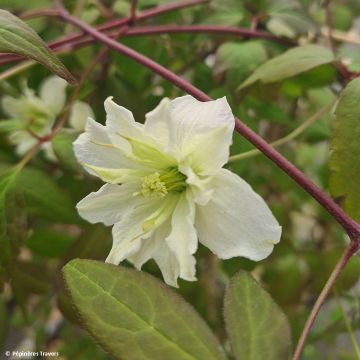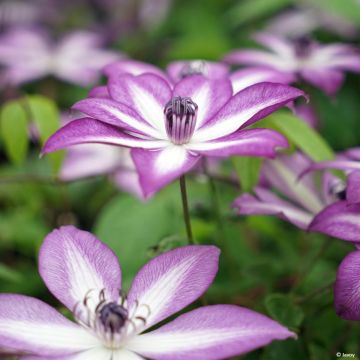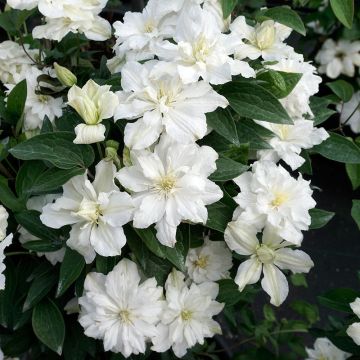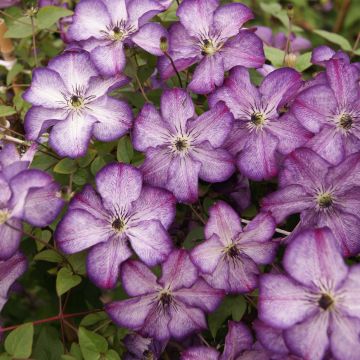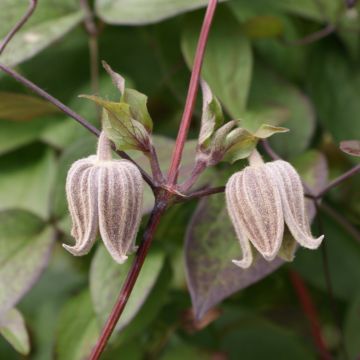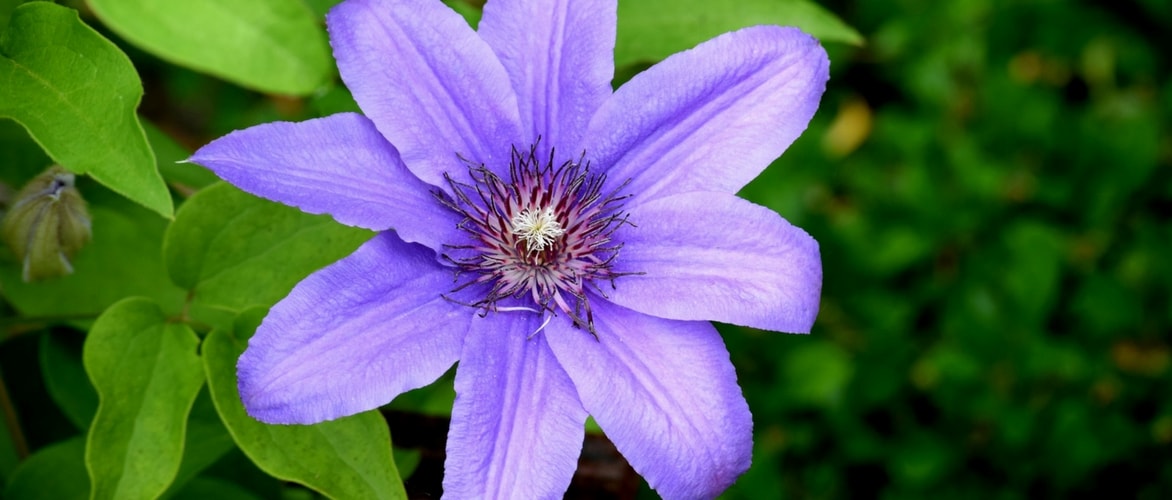
How to plant clematis?
Our tips for successfully planting them in the ground
Contents
Clematis charm us with their large star-shaped flowers. They climb up pergolas and the walls of houses, adding a splash of colour. They offer exceptional diversity, both in flower shapes and colours. The flowering can be single, double, or in bell-shaped clusters. It often features shades of pink, mauve, blue, or white. Clematis bring a lot of vitality to flower beds. When paired with climbing roses, they can create a very romantic atmosphere! Discover all our tips on when and how to plant them.
When to plant clematis?
Clematis can be planted throughout the year, but the most favourable times are spring and autumn. In spring (March to May), temperatures begin to warm up, allowing young plants to establish their roots well before summer. In autumn (September to November), the soil is still warm enough to encourage rooting, while benefiting from natural rainfall. Avoid planting in mid-summer, as heat and lack of water can make it more difficult for young plants to establish, and in winter, as young roots may suffer from frost.
Where to plant a clematis?
Clematis is a demanding climbing plant that requires a carefully chosen location to thrive fully. It enjoys the sun, but its base must remain in the shade to prevent drying out. Ideally, plant it in full sun and shade the base of the plant by placing low perennials or small bushes around it. Some varieties, such as clematis ‘Nelly Moser’, can tolerate a slightly shaded position, making them a good choice for partially sunny spots.
The soil must be rich, humus-bearing, and well-drained. Adding compost or organic matter at the time of planting is recommended to ensure good nutrition. The soil should also remain cool without being too wet, as stagnant moisture can lead to diseases and promote root rot. Additionally, choose a sheltered location from the wind, which can dry out the foliage and weaken the plant.
Clematis develop a deep root system, so they need loose and sufficiently deep soil. Avoid compacted or overly shallow ground, which can hinder their growth. Before planting, thoroughly work the soil to loosen it and ensure it is neither too clayey nor too dry.
Compact varieties of clematis adapt well to pot cultivation to enhance a terrace or balcony. Choose a container that is wide and deep enough, ideally with good drainage, and remember to keep the base of the plant in the shade, even in pots, to ensure optimal flowering and healthy growth.
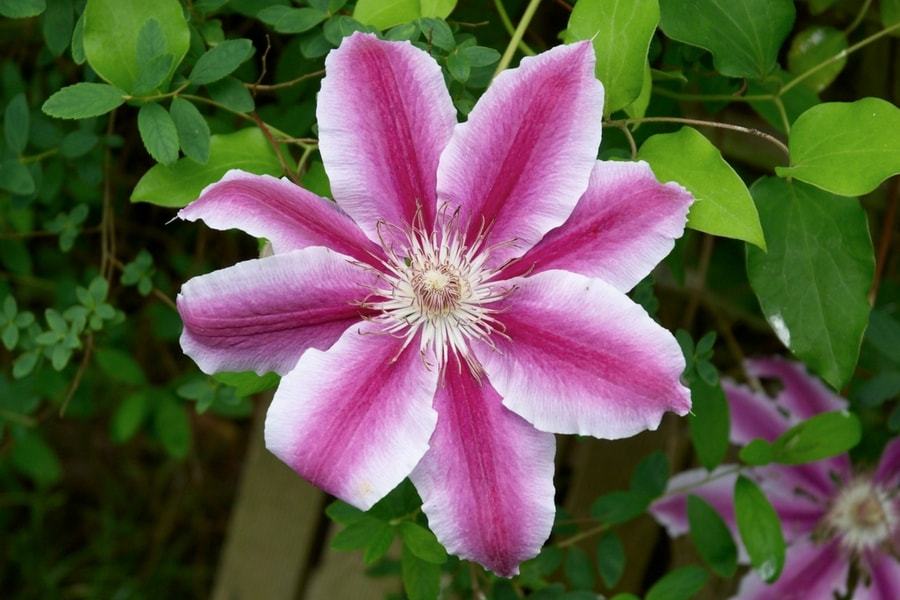
Clematis ‘Dr Ruppel’
Discover other Clematis
View all →Available in 0 sizes
Available in 0 sizes
Available in 1 sizes
Available in 1 sizes
Available in 1 sizes
Available in 1 sizes
Available in 1 sizes
Available in 1 sizes
Available in 1 sizes
Available in 1 sizes
How to plant a clematis?
Start by choosing a solid support suitable for the growth of your clematis. It enjoys trellises, pergolas, fences, or even tree trunks or bushes to cling to and climb. You can also pair it with another climbing plant to create a lush green effect. Handle your clematis with care, as its roots and stems are delicate and can break easily!
- Place the root ball of the clematis in a basin of water and let it soak for 10 to 15 minutes to hydrate it well before planting.
- Dig a planting hole at least 40 cm deep and wide to allow the roots to spread comfortably.
- Mix the removed soil with potting compost and add a handful of organic fertiliser to enrich the soil. This will give your clematis a good start and a nutrient-rich soil.
- Place a layer of gravel or small stones at the bottom of the hole to improve drainage. This is crucial to avoid stagnant moisture, which can cause diseases and root rot.
- Return some of the soil and compost mixture to the hole, then place the root ball of the clematis slightly tilted towards its support. You can even tilt it horizontally to encourage better branching. Be sure to bury the base of the stems by about 10 cm, which will help protect the plant and promote new shoots.
- Add the rest of the substrate into the hole, then gently firm the soil around the root ball to ensure good contact with the soil without damaging the roots.
- Water generously, directing the stream towards the soil to avoid splashing the leaves and the base of the plant, which could encourage diseases.
- Guide the first stems towards their support to encourage them to cling from the start.
Tip: Plant low-growing perennials or install mulch around the base to keep the roots in the shade and retain moisture.
Also, check out our video tips for planting clematis!
⇒ To discover the different varieties and all our growing tips, check out our complete guide to clematis.
How to care for a clematis?
Continue to water regularly during the first year of planting, especially in dry weather, to help the clematis establish itself well. Once well-rooted, it will require less water and can go without watering, except in cases of prolonged drought.
Install a mulch around the base of the clematis, ideally made from pine bark, straw, or compost, to retain moisture and prevent the soil from drying out too quickly. You can also plant low perennials or small bushes nearby to naturally shade the base and protect the plant from direct sunlight.
Young clematis plants are often favoured by slugs and snails. To keep them away, you can place wood ash, crushed eggshells, or wood chips around the plant. If these natural methods are not sufficient, opt for traps or slug barriers, ensuring to use products that are safe for other organisms in the garden.
Prune the clematis once a year to encourage flowering and maintain a beautiful shape. The pruning period depends on the variety: spring-flowering varieties are pruned after flowering, while summer-flowering varieties are pruned in late winter.
To promote abundant flowering, apply a little potash-rich fertiliser, such as a fertiliser for flowering plants or well-rotted compost, at the beginning of spring. However, avoid excess nitrogen, which promotes foliage at the expense of flowers.
With these simple care tips, your clematis will grow vigorously and provide you with spectacular blooms year after year!
- Subscribe!
- Contents
































